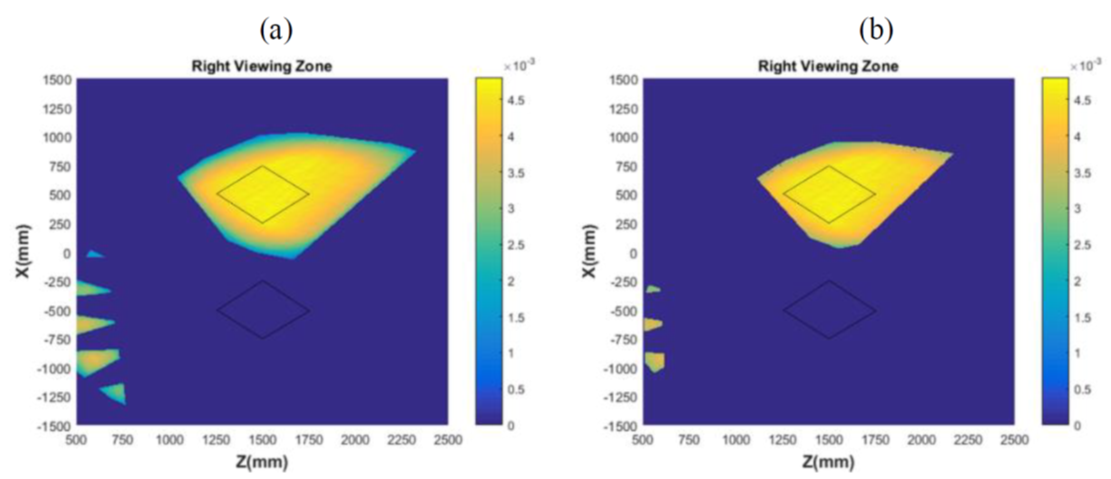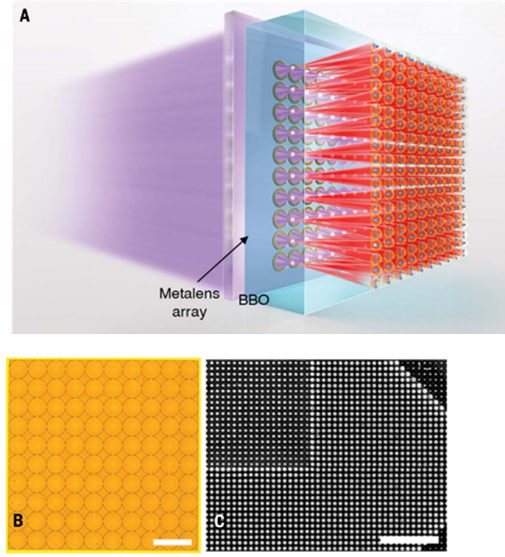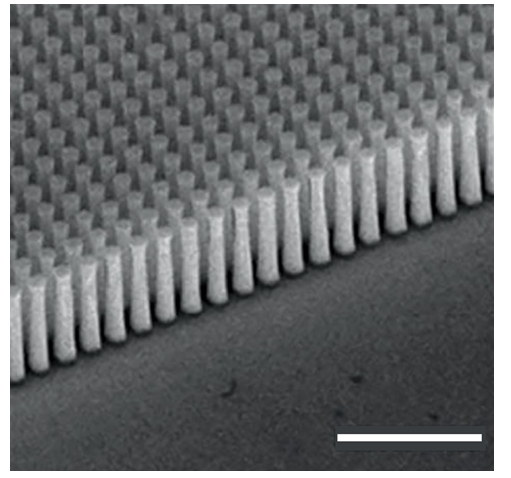 |
|
 |
| |
發行人:黃建璋所長 編輯委員:曾雪峰教授 主編:林筱文 發行日期:2020.10.30 |
| |
|
 |
|

本所林恭如教授指導博士生高士勛同學榮獲「OECC 2020會議最佳壁報論文獎」,特此恭賀!
| 獲獎學生 |
指導教授 |
論文題目 |
|
光電所
高士勛博士生 |
林恭如教授 |
Power
Envelope Detection of 40-Gbit/s GFDM
Data in Two-color VCSEL Based MMW-Oscillator-Free
5G Network |
 本所吳肇欣教授指導碩士生梁雅婷同學榮獲「OECC
2020會議最佳論文獎及最佳現場演講獎」,特此恭賀!
本所吳肇欣教授指導碩士生梁雅婷同學榮獲「OECC
2020會議最佳論文獎及最佳現場演講獎」,特此恭賀!
| 獲獎學生 |
指導教授 |
論文題目 |
|
光電所
梁雅婷碩士生 |
吳肇欣教授 |
Monolithically Integrated Opto-Electrical
NOR Gate Using Light Emitting
Transistors |
|
|
 |
|
 |
|
| |
|
 |
Development of mesoscopic nonlinear imaging system with record-dense sampling capability
Professor Chi-Kuang Sun
Graduate Institute of Photonics and
Optoelectronics, National Taiwan University
臺灣大學光電所 孫啟光教授
Nonlinear imaging [1] of volumetric biological specimens can reveal its three-dimensional (3D) structural details with ultra-high spatial resolution, in terms of depth-resolved cross-sectional views with a better penetration capability due to the use of near-infrared (NIR) excitation spectrum and excitation localization of nonlinear optical absorption, in comparison to single-photon based imaging modalities. To facilitate high-speed, but aliasing-free laser-scanning of a centimeter-scale volumetric sample, an ultra-large field of view (FOV) is mandatory, which must be digitized with an ultra-fast sampling rate in order to fulfil the Nyquist Criterion, being a fundamental limitation to all the state-of-the-art mesoscopic imaging systems to date [2].
Our group has developed a nonlinear optical mesoscope (NLOM) with an extended FOV of up-to 1.6×1.6 mm2 while preserving a smallest resolvable spacing of 0.48 μm. We further introduced a one-pulse-per-voxel extreme-synchronized-sampling for the first time in an NLOM with a FOV/ resolution ratio over 3000. Our record acquisition system holds the capability of simultaneously sampling 4 channels at up-to 125 MSps sampling-rate, reaching a record single-frame pixel number of 15720×16000 for each of the 4 channels, leading to a total of ~1 Gigapixels per frame, while maintaining ~0.5 fps; including real-time calibration, preview and storage of the acquired data in 16-bit format with 14-bit resolution.
|

|
|
Fig. 1(a) 3D view of coronal sections from medulla of a Nav1.8-tdTomato mouse; (b), (c) zoomed views of ROI R1 in (a). Red, green & cyan axes are X, Y & Z axes, respectively. Scale bars: (a) 0.2 mm, (b) 0.1 mm, (c) 0.05 mm. |
Reference:
1.
W. R. Zipfel, R. M. Williams, W. W. Webb,
Nonlinear magic: multiphoton microscopy in the
biosciences. Nature biotechnology,
21,1369–1377 (2003).
2 .
M.
Balu, H. Mikami, J. Hou, E. O. Potma, B. J.
Tromberg, Rapid mesoscale multiphoton microscopy
of human skin. Biomedical Opt. Express 7,
4375-4387 (2016).
Study on the Design Parameters for Curved-Type Parallax-Barrier Dual-View Display
Professor Hoang-Yan Lin
Graduate Institute of Photonics and
Optoelectronics, National Taiwan University
臺灣大學光電所 林晃巖教授
The 3D stereoscopic display makes both eyes to see the left and right image information separately, and recombine them to create stereoscopic vision. The dual-view display distributes the left and right images to each viewing zone, which can be realized through spatial multiplexing methods. The image information can be divided into different position by adding the parallax-barrier or lenticular-lens structures on the display system. The difference between the dual-view and 3D stereoscopic displays is that the viewing position is changed from the distance between both eyes of a person to the double viewing zones which can be designed by yourself. It becomes a technology that can provide at least two users on a single display at the same time. In recent years, the advancement of flexible substrate technology has brought attention to the issue of curved display. Curved displays provide screen-enlarged perception and immersive vision experience.
For the dual-view display, viewing position and the range nearby strongly affect image quality. Viewing zone describes the spatial range in front of the display where a viewer could move around while experiencing the corresponding image information. Regarding a curved dual-view display, radius and viewing angle of the screen determine the relative degrees of bending, by which the spatial light distribution can be determined. In addition, this is a key factor influencing image quality, especially for the display which directs the views for left and right viewing zones based on different image information. By using geometric optics and ray-tracing software, the viewing zone can be calculated and depicted, and discussed as given different curvature radius or viewing angle of the screen with refractive index substrate. Considering crosstalk and uniformity, we present a method to control the viewing zones by shifting parallax barrier in this study.
A curved-type parallax barrier dual-view display was constructed and shown as in
Fig. 1(a). PD and PB are the pitches of the sub-pixel on display and the barrier aperture, respectively. A distance from the display to barrier is defined as f, a distance from barrier to a viewer is defined as
ZDEP, and the dual people distance (DPD) is marked as PE. The geometric relationship is similar to our preview study for 3D stereoscopic displays. First, we take the emitting light rays through the sub-pixel edge to intersect in front of the display. Considering the radius of curvature, the design viewing positions on the left and right must be rotated into a plane parallel to the sub-pixels. The line of intersection point is the barrier, and the opening position of it can be calculated from the period of the barrier. By connecting the edge sub-pixels with the opening position of the parallax barrier, the right viewing zone, corresponding points STUV, can be calculated and depicted. ∆x and ∆z are the width and depth of the viewing zone, respectively. The left viewing zone can calculated an depicted in the same way.
Considering crosstalk and uniformity, it is defined that the crosstalk value must be less than 10%. Under the condition, the received image information will not be blurred or distorted. The uniformity value must be greater than 60%. Human eyes face the entire screen so that there is no uneven brightness problem. Spatial luminance distribution of the right viewing zone is shown as Fig. 2, (a) without considering crosstalk and uniformity, and (b) with crosstalk and uniformity situation.
|

|
|
Fig. 1. Construction of curved type parallax barrier dual-view display |
|

|
|
Fig. 2. Spatial luminance distribution of the right viewing zone |
Reference:
Yen-Wen Lin, Wei-Chen Chen, Hoang Yan Lin, Study on the Design Parameters for Curved-Type Parallax-Barrier Dual-View Display, submitted to OPTIC 2020.
|
 |
| |
|
|
|
 |
|
| |
|
 |
—
資料提供:影像顯示科技知識平台 (DTKP, Display Technology
Knowledge Platform) —
—
整理:林晃巖教授、卓真禾 —
可擴展光源
隨著量子技術的不斷發展,人們越來越需要探索高維度糾纏態和多光子狀態以進行資訊處理。然而,這些任務需要新形式的大規模、可控制和穩定的量子光源。
現在,Lin Li和來自中國大陸、香港和台灣的同事,共同展示了一種具有100個路徑的自發參量下轉換(spontaneous parametric down-conversion, SPDC)光子源,此光源是透過將10×10超穎透鏡與薄(0.5毫米厚度)的非線性晶體β-硼酸鋇(BBO)結合而得到的。(請見圖一A到C)(Science
368, 1487–1490; 2020).
|

|
|
圖一、量子超穎透鏡陣列的示意圖和特徵。(A)基於超穎透鏡陣列的量子源示意圖。(B)超穎透鏡陣列的顯微鏡圖像。(C)GaN超穎透鏡之掃描電子顯微鏡圖像的頂視圖。 |
超穎透鏡陣列是透過電子束微影術、乾蝕刻和去除光阻來製造的GaN奈米柱的緻密圖案組成。10×10陣列中的每個超穎透鏡的面積為100 μm x100 μm,設計用在404 nm的工作波長下具有1.1 mm的焦距。奈米柱的高度為800 nm且相隔200 nm (如圖二所示;比例尺為1 μm)。
|

|
|
圖二、GaN超穎透鏡之掃描電子顯微鏡圖像的側視圖。 |
為了要用光的相位去控制量子態,將陣列中的超穎透鏡設計為具有不同的初始相位。相鄰超穎透鏡之間存在四個相位差,Δϕ分別為 0,π/ 2,π和3π/ 2。
當二極體雷射(波長404 nm,功率100 mW)入射到超穎透鏡陣列時,在BBO晶體內部形成了10×10的焦點陣列。每個焦點觸發了SPDC過程,並以概率方式生成了糾纏的光子對。因此,分別由兩個,三個和四個超穎透鏡形成了二維(2D),三維(3D)和四維(4D)的糾纏態,這個結果已透過重建和量子態斷層掃描量測得到了驗證。
純2D、3D和4D糾纏態的逼真度,分別估計為0.984、0.966和0.955,接近理想值1。
此外,基於超穎透鏡陣列系統的多光子源,用415 nm飛秒脈衝雷射進行了特性量測。二次泵功率和三次泵功率的相關性分別確認了兩個和三個相鄰超穎透鏡產生的四光子和六光子。透過Hong-Ou-Mandel干涉實驗證實了四光子產生的純度和不可區分性。
Lin Li說:「超穎表面結構可以為產生和控制複雜的量子態提供一條途徑,不僅增加了量子系統的維數,而且還允許對多個光子進行相干控制。」
|
參考資料: |
[1] Noriaki Horiuchi, “Scalable sources,”
Nature Photonics Vol.
14, 530(2020)
https://www.nature.com/articles/s41566-020-0686-x
DOI: 10.1038/s41566-020-0686-x
[2] Lin Li, Zexuan Liu, Xifeng Ren, Shuming Wang, Vin-Cent Su, Mu-Ku Chen, Cheng Hung Chu, Hsin Yu Kuo, Biheng Liu, Wenbo Zang, Guangcan Guo, Lijian Zhang, Zhenlin Wang, Shining Zhu, and Din Ping Tsai, “Metalens-array–based high-dimensional and multiphoton quantum source, ”
Science Vol. 368, Issue 6498, 1487-1490 (26 Jun 2020).
https://science.sciencemag.org/content/368/6498/1487/tab-pdf
DOI: 10.1126/science.aba9779
|
| |
|
|
|
|
|
|
|
|
|
 |
|
 |
|
|
|
 |
|
 |
|